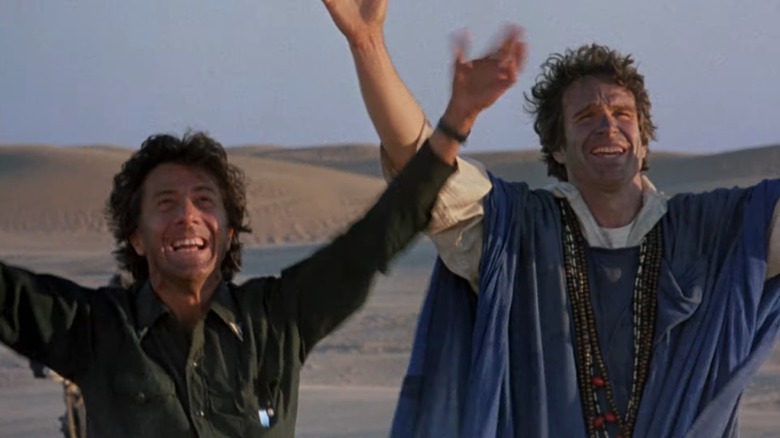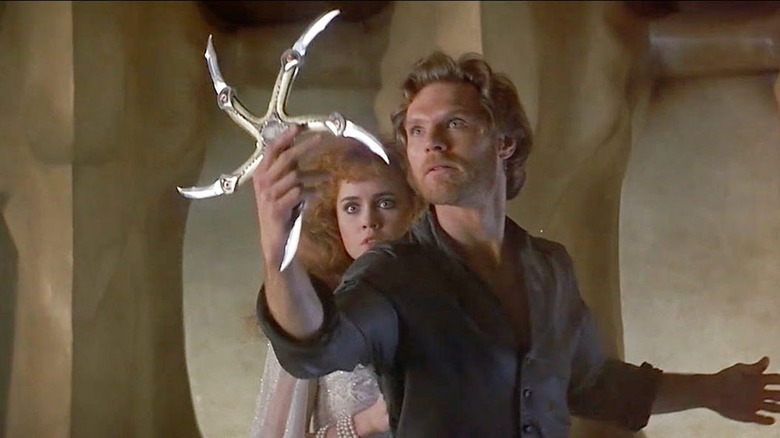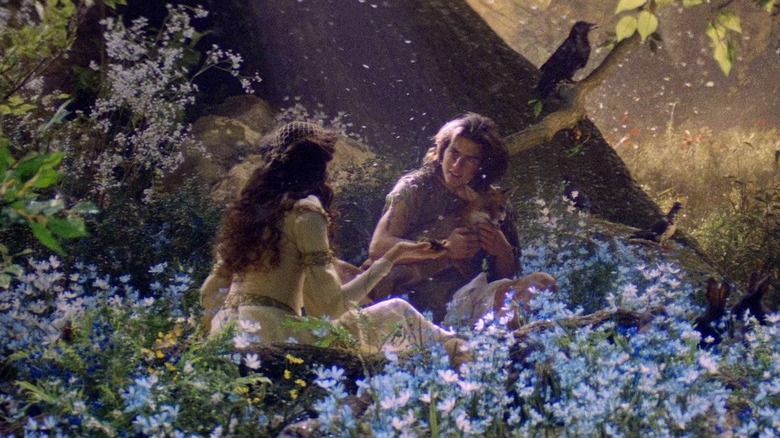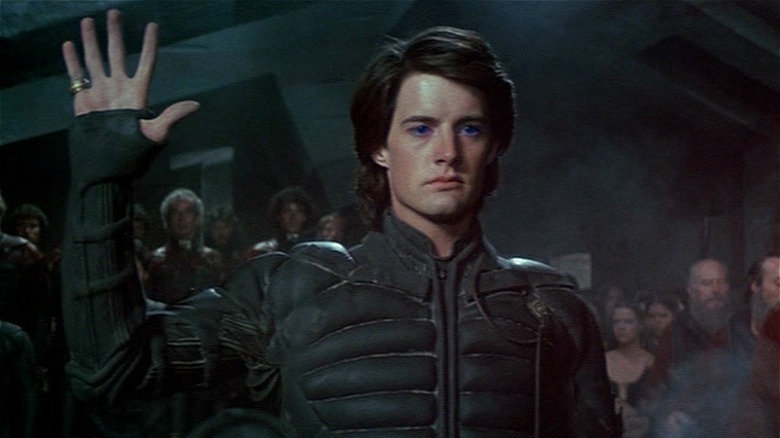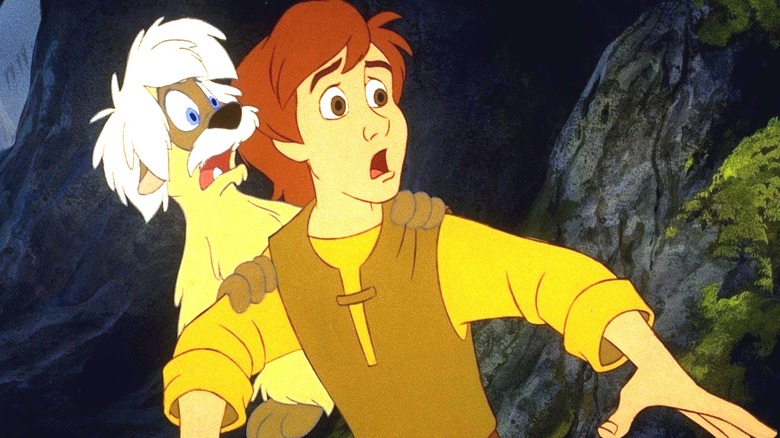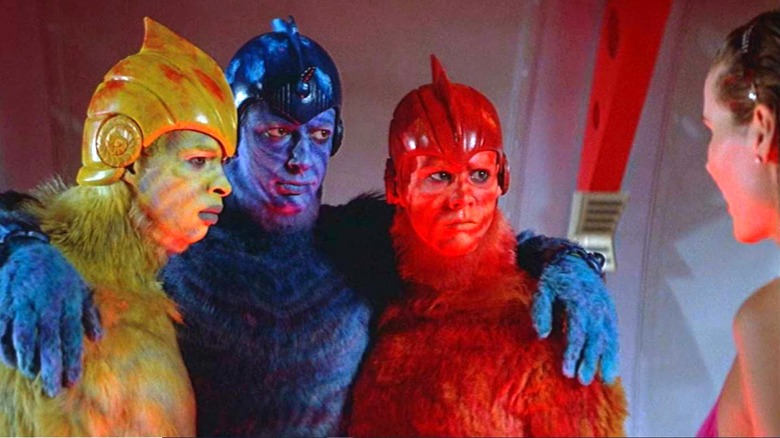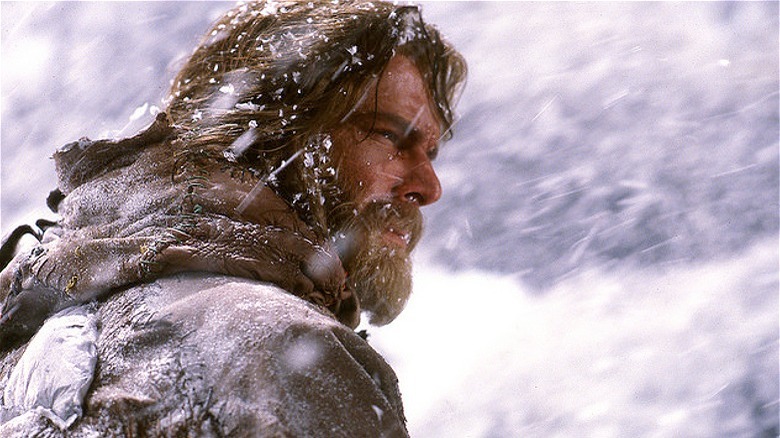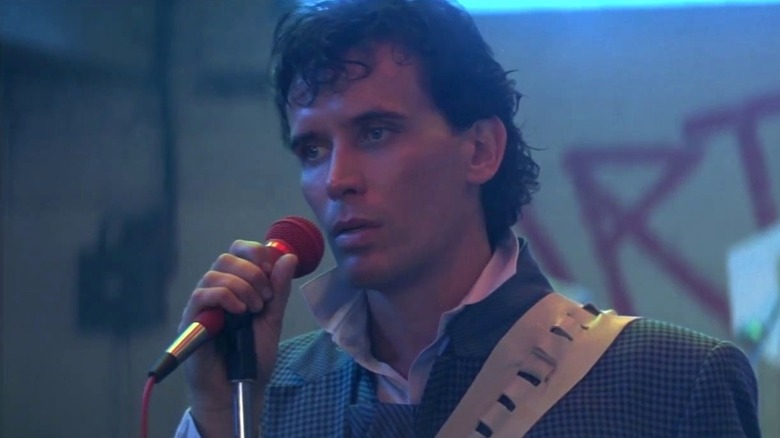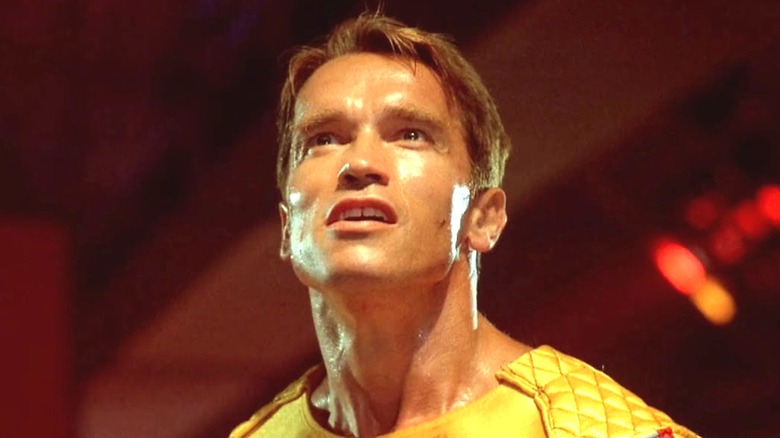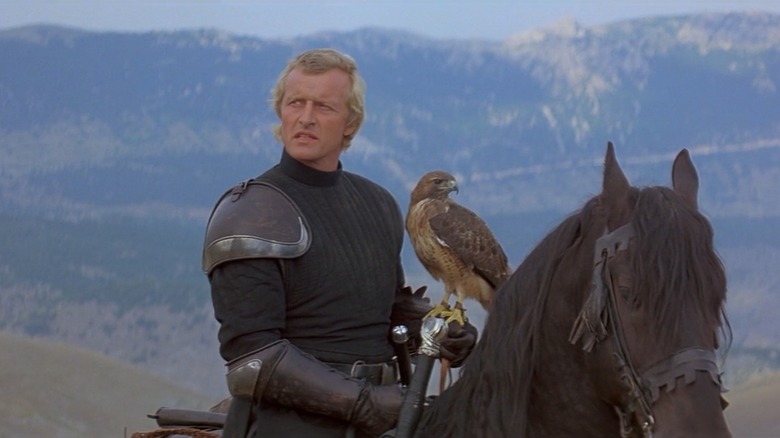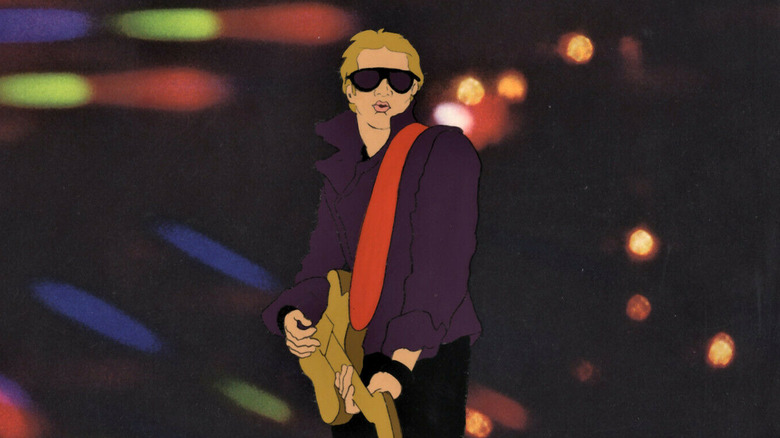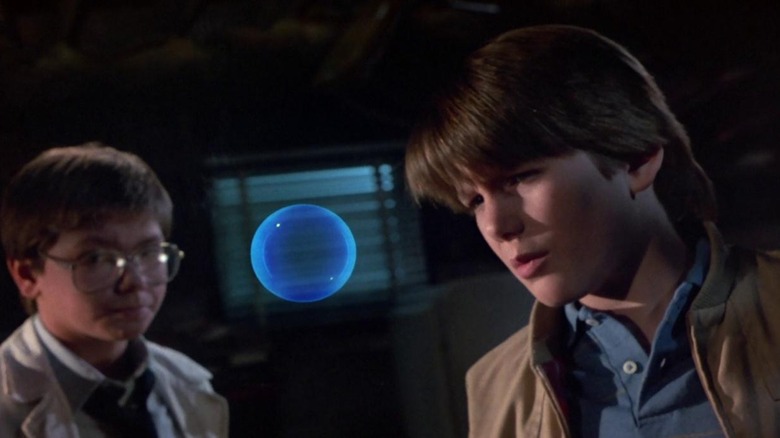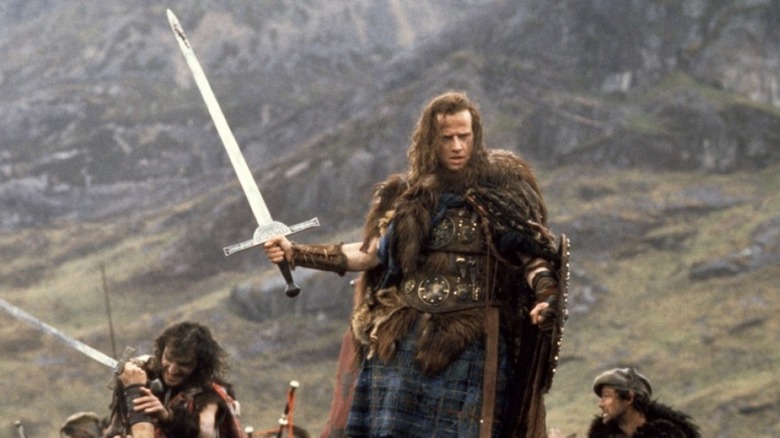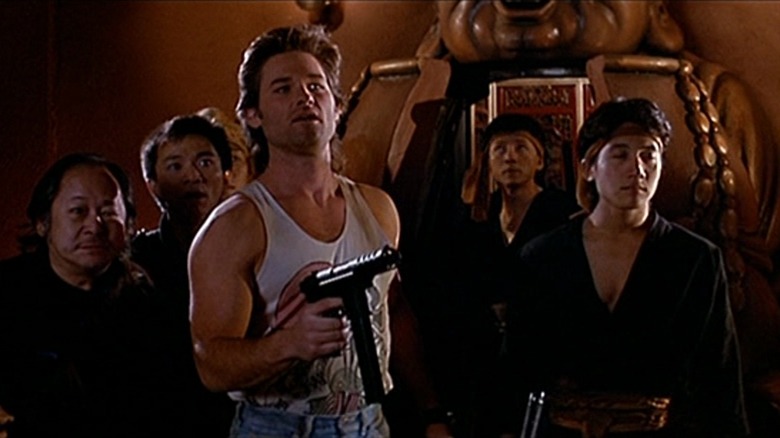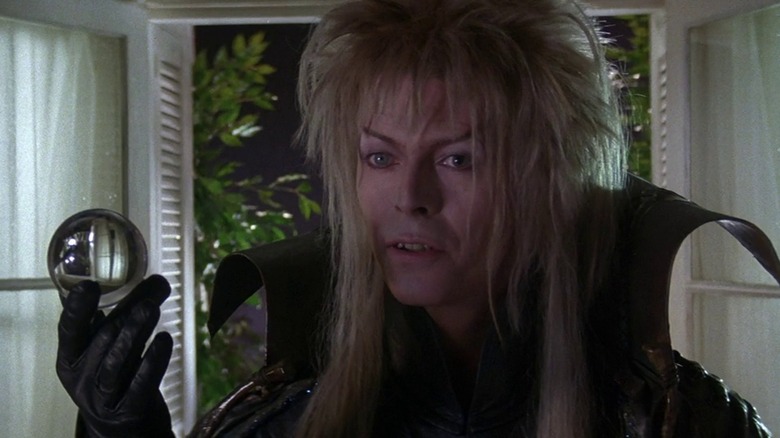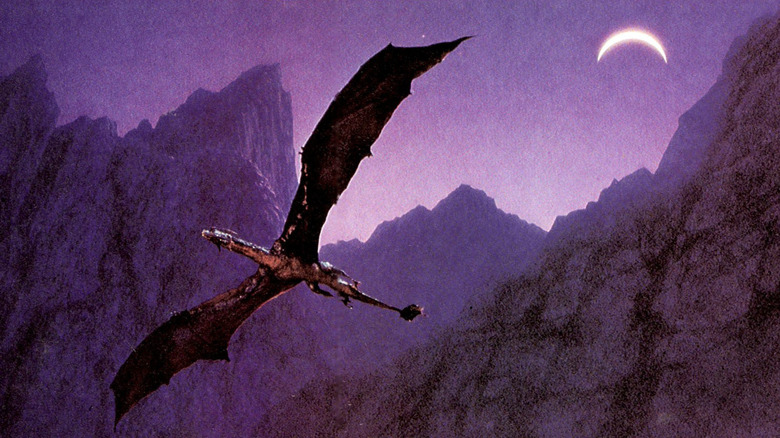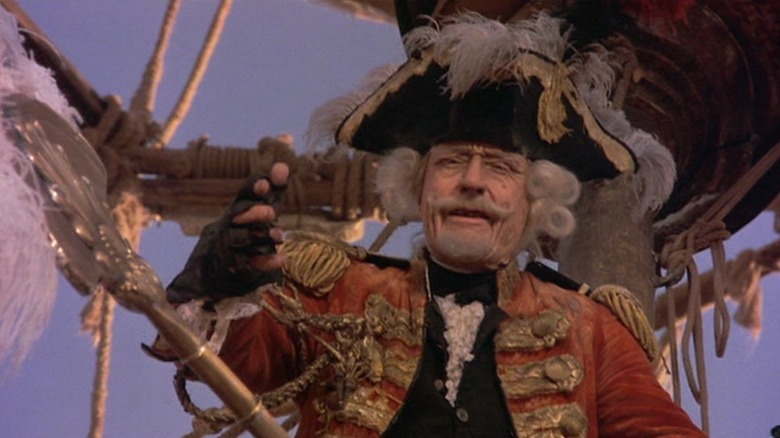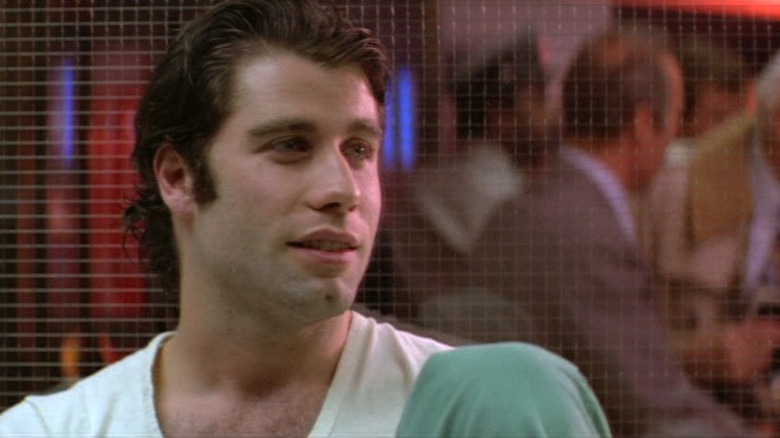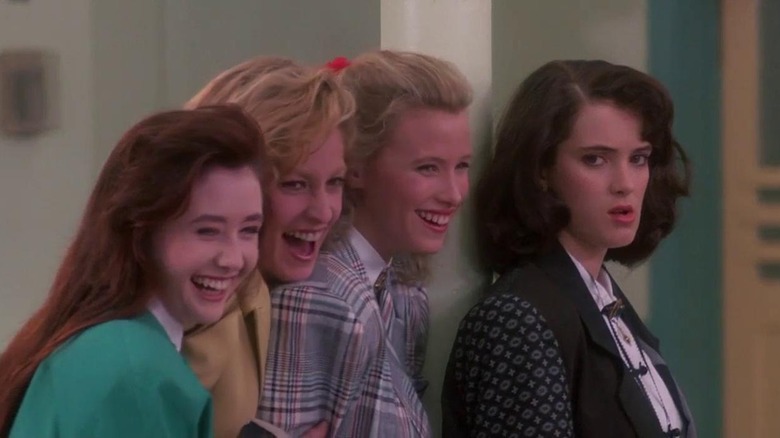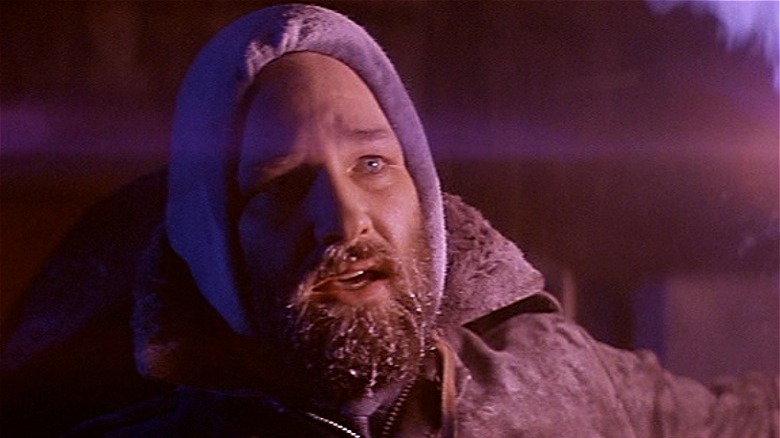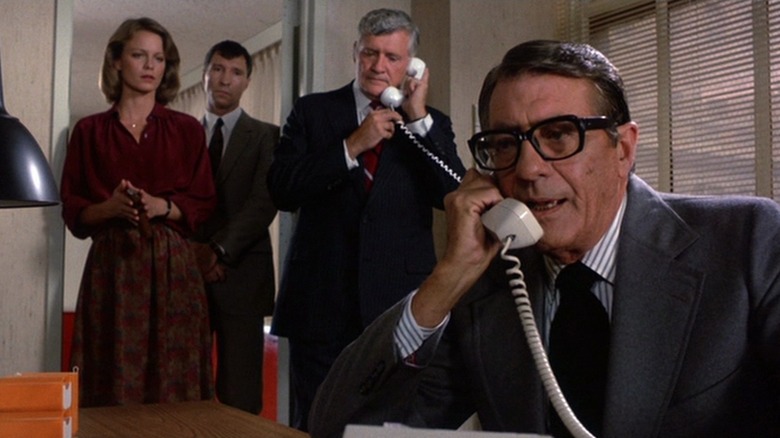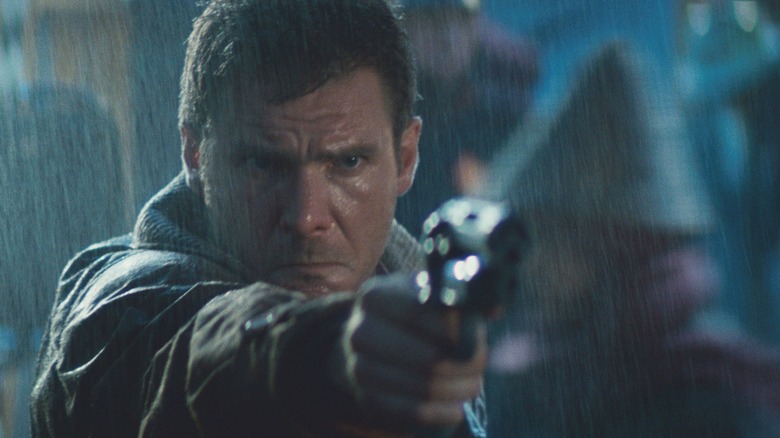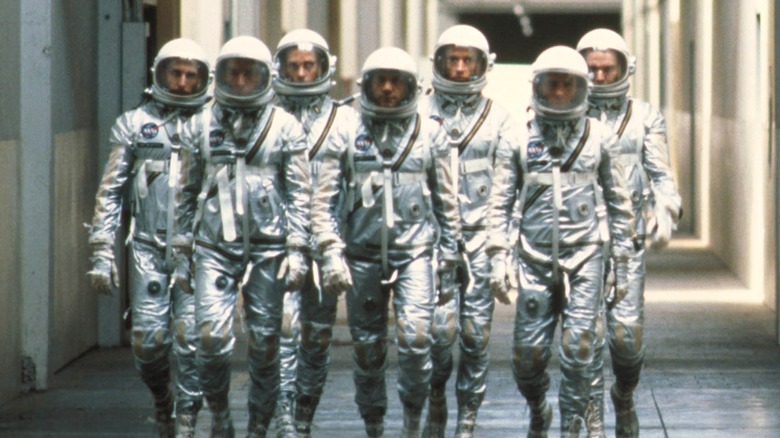'80s Box Office Bombs That Are Actually Worth Watching
Moviemaking is a serious business that involves thousands of people and millions of dollars. Most modern movies cost well over $20 million to produce, with some costing several hundred million to bring to life. When a film does well, it profits the studio, and things keep on rolling. It becomes a serious problem when things go poorly, so box office bombs are no joke.
Conventional wisdom is that a movie must earn as much as twice its production budget to break even. This is because promotional costs often match production costs. Back in the 1980s, films were significantly cheaper to make than they are today, but box office bombs had the same impact. It's unfortunate when a movie fails to earn back its budget, but that doesn't always mean it's a terrible film.
A movie can bomb because of other films released at the same time that are more popular, bad word of mouth, crummy reviews by critics, and more. Whatever the reason, not all box office bombs from the 1980s were terrible. Plenty of cinematic stinkers are well worth your time, and you may be surprised to discover that several films you love weren't financially successful, at least at first.
Ishtar (1987)
"Ishtar" had a lot going for it, with Warren Beatty and Dustin Hoffman co-starring in what aimed to be the next big adventure movie. The film is about two untalented songwriters who travel to Morocco for a booking only to find themselves caught up in a Cold War standoff. When "Ishtar" hit theaters, critics lambasted it as one of the worst movies ever made, and few could argue that point.
"Ishtar" had a production budget of $51 million, which was more than the studio wanted to spend. Initially, "Ishtar" was budgeted for $28 million, but the production ran into numerous problems, one of which was an inflated budget. When the dust settled, "Ishtar" made $14.3 million at the box office. It didn't help that "Beverly Hills Cop II" opened the same weekend, all but ensuring its failure.
Despite being a notorious bomb, time has aged "Ishtar" like a reasonably priced wine you'd serve at a casual dinner party. Richard Brody of The New Yorker called the film "among the most original, audacious, and inventive movies — and funniest comedies — of modern times." Other critics have applied similar praise following the film's re-release on various media over the years.
Krull (1983)
The 1980s was an excellent decade for fantasy films — but not because they made a ton of cash. Many that have since been lauded as cult classics utterly failed upon release, and "Krull" shares that distinction, as an ambitious mishmash of fantasy, science fiction, and mythology genres. "Krull" tells the tale of Prince Colwyn (Ken Marshall) and his merry band of travelers who embark on a quest to rescue Princess Lyssa (Lysette Anthony) from a fortress of alien invaders.
"Krull" failed to woo audiences upon release, and it bombed pretty hard. The estimated production budget was around $47 million, or around $144 million when adjusted for inflation. That's a lot of money for a new intellectual property, costing the studio significantly and ensuring no sequel would see the light of day.
"Krull" made $16.5 million at the box office – but to be fair, it had to compete with "Return of the Jedi." Today, "Krull" is a beloved cult classic, and while it has its detractors, it also boasts a huge fanbase. The film features then-cutting-edge VFX and has a fantastic score by celebrated composer James Horner, so there's a lot for people to like, although some criticized "Krull" for its slow pace.
Legend (1986)
"Legend" is the Ridley Scott film most people missed when it hit U.S. theaters in 1986. It stars a young Tom Cruise, a year before he starred in "Top Gun." Cruise plays Jack, a pure being who embarks on a quest to stop the Lord of Darkness (Tim Curry) from covering the world with eternal night. "Legend" had a lot of star power and studio support behind it, but critics weren't kind to the story and its languid pace.
The studio shelled out $25 million for the film, which only made $23.5 million at the box office. Despite the paltry reception, "Legend" earned numerous awards and nominations, including the Academy Award for best makeup. "Legend" lost to "The Fly," and while both films featured amazing makeup, few could look the Lord of Darkness in the eyes and realize Tim Curry was under all that red paint.
"Legend" languished in cinematic obscurity for years, but Universal saved it by releasing a Director's Cut DVD, restoring several cut scenes and the original Jerry Goldsmith score. "Legend" was already a cult classic before the 2002 and subsequent 2011 re-release, but its popularity grew as more people enjoyed "Legend" for the first time.
Dune (1984)
The first attempt at adapting Frank Herbert's "Dune" for the big screen took over a decade, resulting in a film that somewhat resembles the book. Accuracy was sacrificed for time when a three-hour movie was cut and reshot down to just over two hours. "Dune" follows the same narrative structure as the novel but incorporates elements utterly absent from its source. Despite this, much of the core structure is there, making it a fair adaptation.
"Dune" was an expensive film, costing between $40-42 million to produce, though it made only $30.9 million at the global box office. While it failed in cinemas, "Dune" had a second life via televised broadcast and home video. The 1988 TV version included two parts, totaling 186 minutes. Lynch was so disgusted with the cut that he removed his name, using the pseudonyms of "Alan Smithee" for the director and "Judas Booth" for its writer.
Ultimately, "Dune" earned its fanbase and cult classic status from the home video rental market. While it's not the most faithful adaptation of Herbert's work, it features beautifully imagined characters, places, and themes. The film's visual style alone makes it a work of art, and despite its flaws, it's beloved by many.
The Black Cauldron (1985)
It's rare that a Disney movie doesn't do well, but it's not unheard of: Case in point, "The Black Cauldron." After 48 years of producing one hit after another, Walt Disney Animation Studios dropped a serious bomb. The film follows Taran and his friends as they seek to stop the Horned King from obtaining the titular MacGuffin so he can take over the world. It's a dark fantasy that legitimately frightened children when it was released in theaters.
That's not something Disney likes to do, so the studio slapped it with its first PG rating. Despite removing several scenes, the final cut is still terrifying, thanks to an army of skeletal zombie warriors. "The Black Cauldron" was the most expensive animated film ever made at the time at $44 million. The film made $21.2 million at the global box office, significantly damaging the animation studio's stability.
Fortunately, Disney animation survived "The Black Cauldron," but the film almost didn't. It took 13 years for Disney to open the vault and release "The Black Cauldron" on VHS. Perhaps because of the prior unavailability, the film didn't take long to build a fanbase, and "The Black Cauldron" has become one of Disney Animation's few cult classics.
Earth Girls Are Easy (1989)
You may not know it, but a film starring Jeff Goldblum, Geena Davis, and Jim Carrey hit theaters in 1989 and completely bombed. "Earth Girls Are Easy," built around a song by Julie Brown, is an '80s comedy about a valley girl who befriends three furry aliens — Mac, Zeebo, and Wiploc — after their spaceship crashes into her pool. Once shaven, the fuzzy aliens become attractive men.
"Earth Girls Are Easy" was positively received by critics upon release, but hardly anyone bothered to see it. The film's estimated budget of $10 million made the $3.9 million it earned at the box office a tough pill to swallow. While most people missed out on seeing "Earth Girls Are Easy" in theaters, it blew up via the home rental market and televised broadcasts.
Comedy Central aired the film throughout the '90s and 2000s, ensuring more people watched it. It's now settled nicely into the realm of cult classics beloved for its pure absurdity and the clear indication that nobody took anything too seriously making it. The film is campy, features multiple musical numbers, and includes a then-unknown Jim Carrey, making it worth a viewing.
Enemy Mine (1985)
In "Enemy Mine," humanity has been at war with the Dracs, and it's a bitter fight. Starfighter pilot Willis E. Davidge (Dennis Quaid) hates the Dracs as much as anyone, but when he and an enemy pilot, Jereeba "Jerry" Shigan (Louis Gossett Jr.), crash on the hostile planet of Fyrine IV, they must learn to trust one another to survive. The story follows these two enemies as they become dependent on one another and, ultimately, friends.
"Enemy Mine" is arguably one of the greatest science fiction films ever made that hardly anyone saw. The film hit theaters in 1985 after a number of production issues and cost overruns. "Enemy Mine" was budgeted for $17 million but ended up costing upwards of $48 million when it was finished. That's a significant increase, and the studio didn't see a return on its investment with the film's paltry $12 million box office pull.
Initially, "Enemy Mine" received moderate criticism, which didn't help it score much cash at theaters. When it was released in December 1985, it was up against "Rocky IV," "Spies Like Us," "Santa Claus: The Movie," and "The Jewel of the Nile," and it struggled with the competition.
The Adventures of Buckaroo Banzai Across the 8th Dimension (1984)
Of all the zany movies produced in the 1980s, "The Adventures of Buckaroo Banzai Across the 8th Dimension" has to be the strangest. The title is a mouthful, and the film doesn't hold back in throwing numerous concepts at the audience. The titular hero (Peter Weller) is a neurosurgeon, physicist, rock star, and test pilot who accesses the 8th dimension while testing a Jet Car through solid matter.
"Buckaroo Banzai" is everything modern cinema isn't: It's risky, weird, and a lot of fun without any attempt at being serious. What's left is a cult classic starring a ton of talent, including John Lithgow, Ellen Barkin, Jeff Goldblum, and Christopher Lloyd. "Buckaroo Banzai" cost 20th Century Fox $17 million to make, and it only managed to rake in around $6.3 million.
Despite this massive loss of cash, "Buckaroo Banzai" was adapted into more than a single film. There are comics, novels, and even a video game, so it permeated pop culture just enough to build a cult following. While the film is undoubtedly campy — Lithgow's Dr. Emilio Lizardo especially so — it's a fun ride to the 8th dimension any sci-fi fan should see.
The Running Man (1987)
"The Running Man" is an adaptation of Stephen King's novel of the same name, published under his pseudonym, Richard Bachman. The film takes place in the distant future of 2017 when the U.S. is a totalitarian police state. The global economy has collapsed, and the most popular escape is a television show called "The Running Man." Contestants are unwilling criminals thrown into a hellscape filled with Stalkers out to kill them.
The film centers around Captain Ben Richards (Arnold Schwarzenegger) and his time in the hot seat. Since it's a Schwarzenegger movie, you already know there are tons of one-liners and ultra-violence. These days, fans of the Governator see "The Running Man" as one of his classic films from the '80s, but it didn't fare well upon release.
"The Running Man" cost around $30 million to produce, and although it made $38 million at the box office, coupled with promotional costs it was technically a dud. Nowadays, "The Running Man" isn't so much a cult classic as it is a well-regarded and beloved Schwarzenegger romp worthy of any binge-fest.
Ladyhawke (1985)
"Ladyhawke" is a fantasy tale centered around a thief called "The Mouse" (Matthew Broderick) who busts out of a dungeon and soon finds himself involved in a dangerous plot led by the Bishop of Aquila, to hunt down a warrior, Etienne of Navarre (Rutger Hauer) and his lady, Isabeau d'Anjou (Michelle Pfeiffer). The Mouse is out for himself initially, but eventually becomes the hero of his own story.
The film came out shortly after "WarGames" and just before "Ferris Bueller's Day Off," so Broderick was something of a rising star at the time. Unfortunately, almost nobody bothered to watch his foray into the fantasy genre in theaters. The studio shelled out $20 million for "Ladyhawke" and only saw a return of $18.4 million in ticket sales. The film passed into obscurity for a while and only managed to claw out with Broderick's increased fame.
Despite failing to garner much attention from audiences upon release, "Ladyhawke" received two Academy Awards nominations. While it didn't win for best sound or best sound effects editing, "Ladyhawke" did win a Saturn Award for best fantasy film. These days, it's remembered for its excellent characters, rich sound, and exceptionally well-written romance, typically lacking in fantasy films.
American Pop (1981)
Animation in the early 1980s often delivered outstanding films, many of which didn't earn much money at the box office. This was often due to an expanding market of adult-oriented animation in conflict with more traditional cartoon films for children. Ralph Bakshi's movies often struggled to woo audiences upon release, only to become cult classics discovered in the home rental market. A great example of this is "American Pop."
The film follows four generations of an immigrant family filled with musicians. Each generation tells the tale of their American journey as they navigate the perils of history's most significant events, including the Great War, WWII, the Civil Rights Movement, counterculture, and more. Like most of Bakshi's work, "American Pop" features a mix of animation styles and archival live-action footage.
"American Pop" was a relatively expensive film, costing approximately $5 million to produce. Unfortunately, it only made $6 million at the box office. "American Pop" has gained a wider audience as a cult classic and offers an exceptional and eclectic amalgamation of 20th-century music. The soundtrack complicated release on home video due to rights issues, so the film didn't come out on VHS until 1998.
Explorers (1985)
"Explorers" is one of those movies that, if you saw it as a kid, you absolutely loved it. If you missed out, you either won't like it as an adult, or you've lived your life ignorant of its existence. "Explorers" is a quintessential kids' movie about a group of teens who discover a means of flying into space. They meet some aliens, have a taste of adventure, and become better friends by the end.
"Explorers" suffered a fate common to many sleeper hits — the competition killed it. When it was released in July 1985, "Back to the Future" was in its second week in theaters, ensuring nobody dropped a few bucks to see the latest Joe Dante film. "Explorers" also fought for ticket sales against a re-release of "E.T." and "The Goonies," which was released the month prior but was still dominating the box office.
"Explorers" had a poor showing at the box office, earning just shy of $10 million. The film features numerous SFX shots that ended up costing Paramount Pictures $24 million, making "Explorers" a genuine box office bomb. Many eventually discovered it on VHS, ensuring it achieved cult classic status.
Highlander (1986)
"Highlander" follows the unending life of Connor MacLeod (Christopher Lambert), a 16th-century warrior from the Scottish Highlands. A monster of a man called the Kurgen kills him in his first battle in 1536, but instead of rotting, he wakes up as good as new. Connor is an Immortal, a group of people who can only die via decapitation. The Immortals are drawn to a particular place and time for the Gathering to battle for the Prize.
It's an unusual premise, but it makes for an exceptional fantasy action-adventure flick set in 1980s New York City. "Highlander" cost $16 million to make, and it only earned $12.9 million at the box office. Despite this, the film gained a significant following, and it became a multimedia franchise consisting of multiple sequels, a popular television series, a possible reboot starring Henry Cavill, and the tagline "There can be only one," which has cemented itself in popular culture.
"Highlander" is a fantastic film for many reasons, one of which is its spectacular soundtrack. Queen provided numerous tracks for the film, including "Who Wants to Live Forever," "A Kind of Magic," and "Princes of the Universe," which opened the TV series' title sequence.
Big Trouble in Little China (1986)
In "Big Trouble in Little China," truck driver Jack Burton (Kurt Russell) finds himself in San Francisco's Chinatown, where he's pulled into a magical plot to help save two women from an immortal demon named David Lo Pan (James Hong). It's incredibly violent and over-the-top — there are monsters, martial arts, magic, and more, which is exactly what you want in a John Carpenter film.
The film was expensive, requiring extensive VFX, elaborate costumes, and tons of makeup. It cost around $25 million to produce, but "Big Trouble in Little China" only pulled in about $11.2 million at the box office. Most critics didn't tear it apart, and the film garnered some positive attention, but it fell victim to the plethora of excellent movies showing in theaters when it dropped in July 1986.
"Big Trouble in Little China" hit theaters alongside "The Karate Kid Part II," "Top Gun," "Aliens," "Ferris Bueller's Day Off," and more. Competition may have killed its earnings upon release, but these days, "Big Trouble in Little China" is a widely beloved cult classic. It's one of those films that works best if you don't try to take it seriously.
Labyrinth (1986)
When Jim Henson and George Lucas worked together, they produced plenty of wonderful content, but fans didn't always appreciate their work at the time. "Labyrinth" is one such film, and it's truly surprising it didn't do well. The film follows Sarah (Jennifer Connelly) as she fights to rescue her baby brother from the Goblin King, Jareth (David Bowie), who holds him in his castle at the center of an otherworldly Labyrinth.
Bowie provided much of the film's music and dominated every scene he was in. Henson's work shines through the many adorable and frightening puppets appearing in nearly every scene. It's a true gothic fairy tale adventure film, and it's magical. Sadly, it bombed. "Labyrinth" cost $25 million to make, and audiences avoided it, preferring to see "Top Gun," "Back to School," or any of the other better-performing films released in June 1986.
Despite tons of star power behind it, the film only took in $14.5 million at the global box office. "Labyrinth" became a hit via the home video market, and these days, fans adore it as a cult classic decades after its release. "Labyrinth" has expanded into a franchise consisting of comics, board games, books, and more.
Dragonslayer (1981)
The 1980s were a good decade for fantasy films, and you can't have a proper movie in the genre without a dragon. Enter: "Dragonslayer," a dark fantasy about a young wizard, Galen Bradwarden (Peter MacNicol), who embarks on a quest to slay the dragon Vermithrax Pejorative, a 400-year-old beast only sated by virgin sacrifice. Much of the story details Galen's adventure, which climaxes as he fulfills the title and becomes a hero.
"Dragonslayer" features numerous creature effects shots and holds the distinction of being the first non-Lucasfilm project to utilize Industrial Light and Magic for its VFX work. The film was relatively expensive to produce, costing Paramount Pictures $18 million to bring "Dragonslayer" to life on the silver screen. The movie's box office earnings of between $6 million and $14 million ensured "Dragonslayer's" failure.
Still, despite being a financial flop in theaters, "Dragonslayer" earned Academy Award nominations for best music and best effects. Fans of dragon movies have long considered it among the best of the genre. While more recent films are far more refined, "Dragonslayer" is an excellent entry from the 1980s, and for a long time, it was arguably the best dragon movie to hit theaters for decades.
The Adventures of Baron Munchausen (1988)
"The Adventures of Baron Munchausen" is one of Terry Gilliam's most ambitious films, as it involved three countries co-producing the epic tale about the 18th-century nobleman's exploits fighting against the Ottoman Empire. Most of the Monty Python crew worked alongside Robin Williams, Uma Thurman, Sarah Polley, John Neville, and more to bring the film to life, and it's as magnificent as the title suggests.
Columbia Pictures paid $46.6 million ($120 million today) to produce the film. That's a sizeable investment, and it wasn't the amount the studio initially authorized. The initial $23.5 million budget exploded over the course of the film's production, which only made matters worse when it earned $8 million at the global box office. Stories of a nightmare shoot and issues with the studio likely contributed to the minuscule ticket sales.
The failure of "The Adventures of Baron Munchausen" doesn't make much sense in hindsight. It received positive reviews and nominations for four Academy Awards. The people who watched it love the movie, and it's not so much a cult classic today as it is a beloved conclusion to Gilliam's "Trilogy of Imagination," featuring Robin Williams as the hilariously over-the-top King of the Moon.
Blow Out (1981)
In 1981, John Travolta starred in Brian De Palma's "Blow Out," a neo-noir thriller that had a lot going for it. The film follows Jack Terry (Travolta), a movie sound effects tech who inadvertently records evidence of the assassination of a presidential hopeful disguised as an automobile accident. This thrusts him into an adventure rife with danger and political intrigue.
Although that sounds like a perfect recipe for a successful thriller, 1981 audiences avoided "Blow Out." The film cost the studio around $18 million to produce, but with little interest driving audiences to the theaters, it only made $13.7 million.
The likely reason for its downfall was poor word of mouth from the scant few who bothered to see it. The film has a dark ending, and filmmakers always take a gamble when they conclude a movie on a down note. It's worked well for films like "Seven" and "Crimes and Misdemeanors," but De Palma's "Blow Out" didn't match up. Still, it remains one of the director's best early films.
Heathers (1988)
"Heathers" is about Veronica Sawyer (Winona Ryder) and her clique of popular girls in high school, all three of whom are named Heather. Veronica is something of an outsider, and she falls for a bad boy, J.D. (Christian Slater). The film plays out much like "Mean Girls," but with much more murder and multiple fake suicides capped off with a bomb exploding at a high school. It's a dark comedy, to be sure.
Despite the tongue-in-cheek critique of its many controversial issues — or possibly because of it — "Heathers" wasn't a hit on release. Roger Ebert gave the film 2 ½ stars, touting its message while pointing out the difficulty some may have in understanding its point of view, writing, "Is this a black comedy about murder or just a cynical morality play?"
"Heathers" wasn't an incredibly expensive film, costing around $3 million to make. Despite this, it lost money, pulling in only $1.1 million in ticket sales. While undoubtedly a financial flop, "Heathers" has stood the test of time, despite its controversial depiction of high school murder, and remains popular to this day. It has since spawned a musical and television reboot that premiered in 2018.
The Thing (1982)
John Carpenter's 1982 remake of "The Thing" is enshrined in cult classic status, but it took some time to get there. The film revolves around an Antarctic research station that becomes infested with the eponymous alien creature. It can assimilate and imitate any other organism, leaving the researchers to question one another. As their trust begins to wane, the Thing tears through the team until hardly anyone is left alive.
"The Thing" stands out for its titular villain, which approximates a dog and several people. It changes with each iteration of its form into a Cronenberg-esque nightmare that disturbs and disgusts anyone who sees it. Unfortunately, the incredible creativity that went into creating "The Thing" wasn't appreciated upon release. The movie received widespread negative reviews and only made $19.6 million off an estimated $15 million budget.
While it's a beloved classic these days, "The Thing" took some time to build up a fanbase. Part of the problem was its release date in June 1982, which put it up against "Star Trek II," "Rocky III," "Poltergeist," "Conan," and most importantly, "E.T." Video rentals eventually made "The Thing" a cult classic, which has grown into a multimedia franchise.
The King of Comedy (1983)
Although Martin Scorsese's directorial efforts are universally praised, his box office receipts haven't always been nearly as consistent. "The King of Comedy" follows an aspiring stand-up comedian, Rupert Pupkin (Robert De Niro), who becomes obsessed with veteran comic Jerry Langford (Jerry Lewis). He believes they are true friends, but in reality, he's little more than a stalker.
Things come to a head when he kidnaps his idol to land a spot opening for his show, and it all ends with massive success, resulting in Pupkin's branding as the King of Comedy. The film has a lot of star power and received considerable praise upon release. Despite this, "The King of Comedy" was in and out of theaters without earning anywhere near its $19 million budget.
The movie brought in just over $2.5 million at the worldwide box office, solidifying it as a box office bomb. Time has only helped the film gain an audience, with reviewers promoting it decades later. Mark Kermode of The Guardian called it Scorsese's greatest film. Perhaps the film's most significant praise came from famed Japanese director Akira Kurosawa, who named "The King of Comedy" one of his favorite films.
Blade Runner (1982)
"Blade Runner" may be the one movie fans never expected to be considered a box office bomb, but sadly, it's an accurate description. The film follows Rick Deckard (Harrison Ford) as he hunts down and "retires" a group of renegade Nexus-6 replicants on Earth. His investigations take him throughout Los Angeles, where he uncovers more than he planned in his hunt for Roy Batty, Zhora, and Pris.
"Blade Runner" was an ambitious project requiring numerous VFX shots. All the effects in the film were created without the benefit of CGI, and they still hold up today. Matte paintings, models, and more came together to bring the world of 2019 Los Angeles to life, and in the end, the studio paid $28 million to produce "Blade Runner."
The film made more than its budget by raking in $32.9 million domestically, with another $8.7 million coming in from overseas. Unfortunately, this wasn't enough to make the film successful, despite its eventual status as a cult classic. "Blade Runner" is now considered one of the greatest science fiction films ever made, and it spawned a sequel 35 years after its release.
The Right Stuff (1983)
"The Right Stuff" details the U.S. military test pilots who developed and operated various vehicles in the burgeoning space program. The film continues with the Mercury Seven and covers the stories of Chuck Yeager (Sam Shepard), Gus Grissom (Fred Ward), Gordon Cooper (Dennis Quaid), John Glenn (Ed Harris), Alan Shepard (Scott Glenn), Wally Schirra (Lance Henriksen), and Deke Slayton (Scott Paulin).
The film is an epic, running for nearly 200 minutes, as it explores the dawn of the Space Race, ending with the conclusion of the Mercury program. "The Right Stuff" cost $27 million to produce, but its ticket sales only amounted to $21.5 million. While "The Right Stuff" had some competition at the box office with "Never Say Never Again" and "The Big Chill," it likely failed to garner an audience due to its length.
Roger Ebert gave the film four stars, naming it the best movie of the year, which was significant praise. While it didn't make much money, "The Right Stuff" nabbed eight Academy Award nominations, winning four in technical categories, including best music, sound, sound effects, and editing. It's one of those films almost everyone agrees is fantastic despite its failure upon release.

